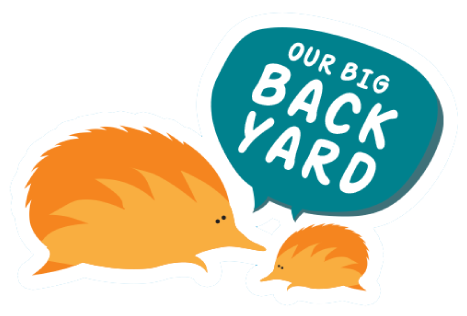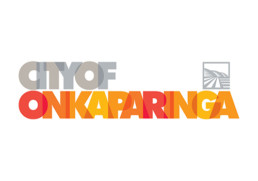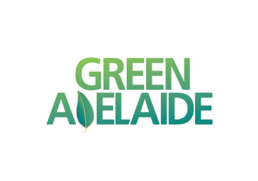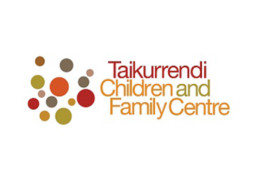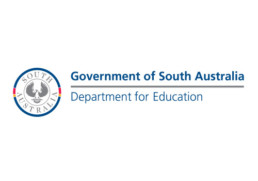Our Big Backyard Christies Beach - South Australia
The Christies Our Big Backyard kit includes:
- A map of the local area identifying natural spaces to explore
- A checklist of 50 things to do in Christies which are all fun, free and outdoors
- Six nature adventure sheets with nature play ideas, tips on how to care for the local environment and interesting information about local native plants and animals.
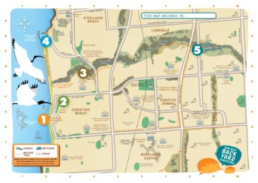
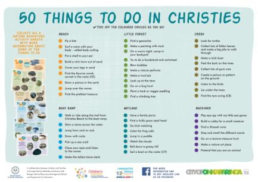
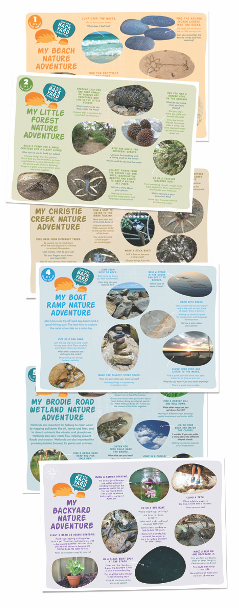
Where can I pick up a free hard copy?
Noarlunga Library
WARDLI Youth Centre
Christie Downs Community House
Taikurrendi Children and Family Centre
O’Sullivan Beach Children’s Centre
What's New?
You can find out more about what’s new with us over on our facebook page by using the button below.
Case Study
The Christies adventure began by gathering a collaboration of educators, environmental educators, and community development workers. It began with an open call for anybody interested in finding out more about Our Big Backyard (OBBY) to attend a meeting in mid-2015.
We were all excited about the potential of having an Our Big Backyard Project in the Christies area. We all saw multiple benefits for a project like this such as:
- Increased pride, community identity, belonging, and ownership in the local Christies area
- Young people having quality time and experiences with their caregivers
- More frequent and positive experiences in our local natural environment
- Feeling confident and comfortable going to public spaces (which helps with natural surveillance and crime prevention)
- Families connecting with their own communities by getting people together
- Privileging the knowledge and experiences of local children and families throughout
Through working together, we all brought different perspectives that were to enhance the development of the initiative as well as further strengthening partnerships and increasing networking. The first few meetings were spent discussing shared values which became guiding principles in developing the project. They included:
- To genuinely consult, involve and engage with local families from the very beginning of the project and for this to inform the construction of the initiative.
- To value and privilege children’s voices in the development of the kit
- To ensure the activities were as accessible as possible e.g. empty hands, local free places, bus routes identified on maps
- To value parents/caregivers as the first educators by giving adults the confidence to play in nature
- Learning through play and nature being an organic teacher
Having a shared understanding of the benefits and values that guided the project was critical to the project team being so productive.
The first step was talking to the community and creating links. We sent out information on the project and started up a Facebook page. We gave out a questionnaire to adults and young people in the local area. Our aim was to consult with the local community and gather their knowledge, history and stories to help us identify and understand the assets of the area. The questions were also designed to collect baseline data about what is happening now and also to find out some great nature play ideas and places the community already visited. The voice of children was critical and we viewed children as our partners. We collected 260 surveys, 180 young people and 80 adults. From the survey and discussions with local families we realised that many young people were going outside of their local area to play. Very few families went to the creek or bush land area to play. When asked, “Are there things that stop you from playing outside?” the main theme was the adults in their lives not letting them due to safety concerns.
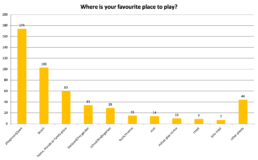
The project team then set out to explore the places people suggested and to find other cool places to play in the local area. We decided on six local places; the beach, your backyard, Christie Creek, Brodie Road Wetland, the boat ramp and the little forest. We then came up with a list of 50 things that could be done at one or more of the locations. The ideas of things to do came from the survey, by the project team visiting the location and feedback from our initial come and try days.
We decided to create nature adventure sheets which gave more information about six of the activities that you could do at the local place. We wanted to do this to help alleviate adults concerns. Information included how to do the activity, any important safety information or ways to protect the local environment and also questions to ask the children. We hoped that once adults felt comfortable in the local place it would lead to children doing what they do best, creating their own play.
“At the come and try days it was great to see kids with adults significant to them having fun together and incredibly special to see them doing something new for the first time – like hearing a frog call, finding sheoak cones and a baby’s first visit to the beach.” Sophie Rogers, NRM Education Officer, Adelaide and Mount Lofty Ranges Natural Resources.
Once we were happy with the draft kit we worked with Heath Riggs from Mono Design. He drew pictures and simplified the design of the nature adventure sheets. Everyone was volunteering their time and resources until this point. This was the first time during the project where we needed funds to be able to move forward. Adelaide and Mount Lofty Ranges Natural Resources and City of Onkaparinga funded the graphic design work. This was also a very time consuming process, ensuring accuracy and consistency across the kit.
Once we had the completed kit we really wanted to celebrate and thank the local community for their involvement in the project. We planned a Family Fun Day at Rotary Park on Sunday 12 November 2017. Over 300 local families attended the family fun day. They were involved in nature play activities including making nature crowns, painting pet rocks, concocting nature perfumes and cubby house building. Many of the nature play activities were organised by local schools and early learning sites. The event was made possible through a Together in the South Collective Impact Grant. One thousand OBBY Christies Kits were distributed at the Family Fun Day and through local organisations, schools and early learning sites just before the end of term four to equip families for the summer school holidays.
Challenges we faced and opportunities that were created
Connecting and consulting with everyone…
- Finding the local stakeholders and how to capture local knowledge
- Finding locals people to connect with
- Changing perspectives
- Challenging notions of risk in nature
- Trying to convince parents to prioritise nature/outings in their lives
- Maintaining momentum within the project
- Securing funding (Council played an important role)
- Coordinating partners: 21 people were actively involved in the project team
What we noticed/community impacts
- Families discovering the opportunities that exist and are available to them at no cost
- Sense of pride and ownership of the local area – talking about what wonderful places we have available and how lucky we are to live where we do as opposed to negative talk
- Parents/grandparents sharing stories of play/outdoor in their childhood
- Calming effect – kids just playing, less complaining, more sustained play,
- They want to look after a place – kids collecting rubbish – keeping their place clean, team work.
- As expected children display curiosity, wonder, imagination, creativity, play
- Connectedness, togetherness – families and community sharing the local spaces together, talking with one another and spending time with their families
- Local champions – people talking positively of Christies and its special places and spaces and memories they have created
- Learning about just how much history exists in the area and learning about First Nations culture
- People realising that they have permission to explore their local area and it can be a natural playground – they don’t have to go to plastic fantastic places to have fun – they will not get in trouble –
- Physically active in children and adults
Quotes from little forest come and try session...
“Im going to pick up the rubbish with a stick”
– kindy girl
Quotes from Wetlands come and try session...
“If you are quiet and listen you can hear the frogs that live here”
– local parent
Taikurrendi Kindy excursion to creek quotes...
“we are building a dragons house”
– kindy boy
“we are making a wardli ( Kaurna Shelter) for our family”
– kindy boy
“Look I’m colouring with flowers”
– kindy girl
Quotes from Other Come and Try sessions held...
“The kids loved it and it makes us value and appreciate our special local area”
“Thank you for teaching us new things”
– Lewis 8
“I learnt so much and the kids had a ball”
– Mark
“It was fun because its great exercise for us”
– Max 7
“I learnt that trees are different, they are smooth and bumpy and leaves can be smooth or bumpy too”
– Ella 5
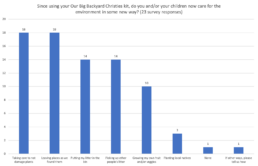
Key findings include:
More time in nature with their families:
- 70% of survey participants noticed an increase in the time they spent with their family outdoors in nature.
Comments included:
“We didn’t know these places were there and what to look for”
“I wasn’t aware that there were such beautiful places like the wetlands etc so close to home”
An Increased capacity to engage with nature
- 57% of survey participants felt more confident in playing outdoors with their family.
- 78% of survey participants now know more about our local plants, animals and environment
Comments included:
“We are out and about and more observant- we notice things more”
“The children and myself have more insight into the habitats of the wildlife and how we can conserve the beauty of their habitats.”
People being empowered to care for their local environment
- 77% of survey participants now appreciate nature more
- 91% of survey participants now see our local environment as something to be protected
- 87% of survey participants felt they cared more for the local area and 91% of survey participants now want to contribute to making the local area a better place for everyone.
- 74% of survey participants now know how to care for our local environment
- 87% of survey participants now care for the environment as a habit
- 83% of survey participants now feel like your actions can make a positive difference to our local environment
- 83% of survey participants now encourage others to care for the environment
Comments included:
“We are more aware of the places in our community and want to keep them pristine and beautiful”
“We have always cared for the environment but seeing the state of our local area we do clean more”
Example: Survey (2019) consultation response
“I think it’s a great idea and I keep telling all my friends and family about it because it’s lots of fun”
“The activity sheets helped us explore more of the previously unknown sites and the wildlife that we never knew were there, or we found new things to look at it helped us take more time to appreciate the beauty of nature more. Such an amazing idea to help with educating the children into new things to do. We even made our own activity sheets to note the things we saw at our local parks and the kids really enjoy the exploration of it all. And give the children an understanding into why we have to look after the environment and the animals in them. Very grateful for this activity.”
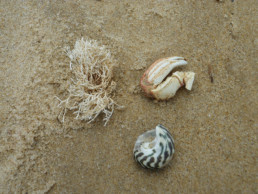
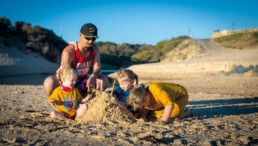
What's next?
The Our Big Backyard Christies working group decided to run train the trainer sessions 18 months after the Our Big Backyard Christies kit was developed. It was hoped that the train the trainer sessions would build the confidence of local workers and community leaders and encourage more groups and families to engage in the activities with the kits in our local natural places. This will help sustainability of the Our Big Backyard project and share the work load. We ran four sessions over 2019 and already participants have run their own come and try sessions with groups they work with. We have also recently updated our kits based on further community feedback for example, an Ibis will be seen flying over the Christies coast now instead of a seagull. We continue to commit to this being an evolving and developing project deeply connected in our community.
For any more information on this project please contact the City of Onkaparinga on 8384 0666 or mail@onkaparinga.sa.gov.au.
